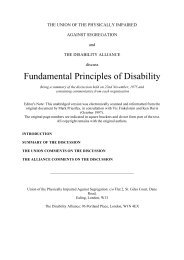Global-Report-Living-Colour-dr2-2
Global-Report-Living-Colour-dr2-2
Global-Report-Living-Colour-dr2-2
You also want an ePaper? Increase the reach of your titles
YUMPU automatically turns print PDFs into web optimized ePapers that Google loves.
Inclusive Communities = Stronger Communities<br />
GLOBAL REPORT ON ARTICLE 19: THE RIGHT TO LIVE AND BE INCLUDED IN THE COMMUNITY<br />
113<br />
Drawing on the Canadian and USA experience, the Canadian Association for Community <strong>Living</strong> – People First of Canada<br />
Joint Task Force on the Right to Live in Community has identified 10 key recommendations as critical to creating real<br />
homes and planning the closure of an institution (The Right Way, 2010). To summarize, these are:<br />
• Involve champions for community living<br />
o<br />
The decision to close an institution requires vision, passion, leadership— and champions. While these champions<br />
can come from many sectors, traditionally family members and self-advocates take the lead role in demanding<br />
both institution closures and community supports.<br />
• Ensure that the needs and preferences of the person come first<br />
o<br />
Each individual must be empowered to choose where and with whom to live and the resulting living arrangement<br />
must truly be that person’s home.<br />
• Respect the experiences and roles of families<br />
o<br />
The perspectives of families must always be taken into account when initiating planning for an individual to move<br />
to his or her own home in the community. Families will often be the best source of information about the person<br />
and often form the nucleus of the person’s support network in the community.<br />
• Facilitate person centred plans and create a real home for each person<br />
o<br />
Engaging in respectful, person-centred planning will maximize the potential for achieving positive personal<br />
outcomes. The goal is to support the individual in ways that meet his or her needs and allow him or her to live in<br />
a real home, to participate meaningfully in community life, to make real choices and have his or her rights and<br />
wishes respected.<br />
• Create quality supports, services and safeguards<br />
o<br />
Resources previously allocated to the institutions are reallocated to communities to ensure adequate capacity to<br />
support everyone in the community. The need for increased capacity in communities is identified in a systematic<br />
and timely way, so that planning can occur and supports are in place when individuals make the move to their<br />
new homes.<br />
• Recruit and develop qualified support staff<br />
o<br />
The availability of skilled, knowledgeable employees to provide the individualized supports needed by individuals<br />
with intellectual disabilities in their homes and communities is vital to success. Many former institution staff can<br />
successfully transition to community-based environments and strategies for accommodating these staff need to be<br />
developed.<br />
• Establish community partnerships<br />
o<br />
The successful closure of an institution depends on sound collaborative working partnerships between individuals,



